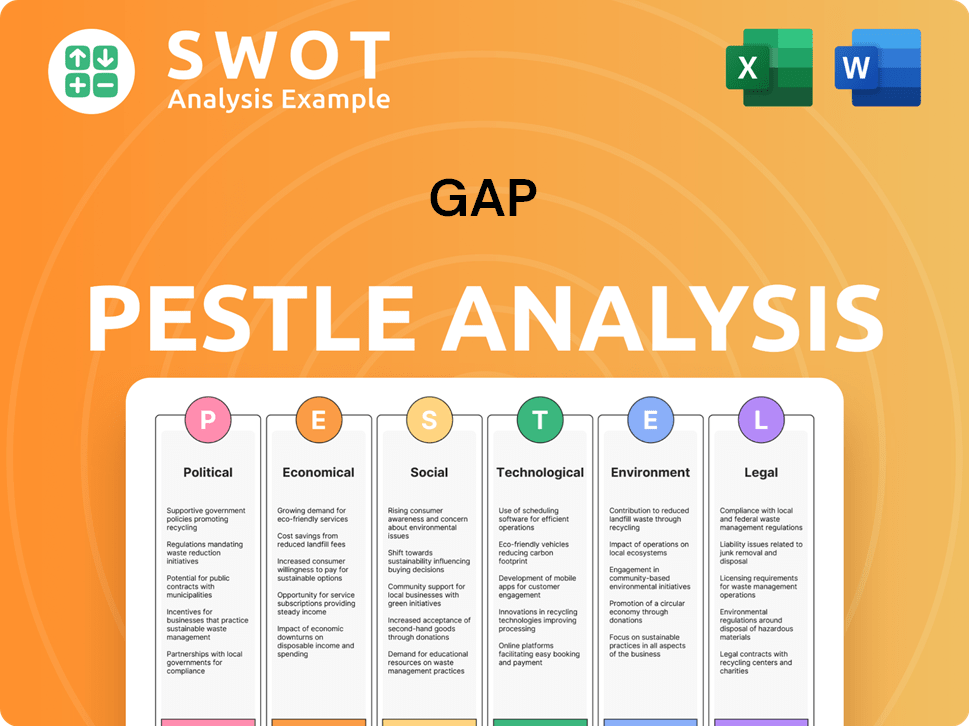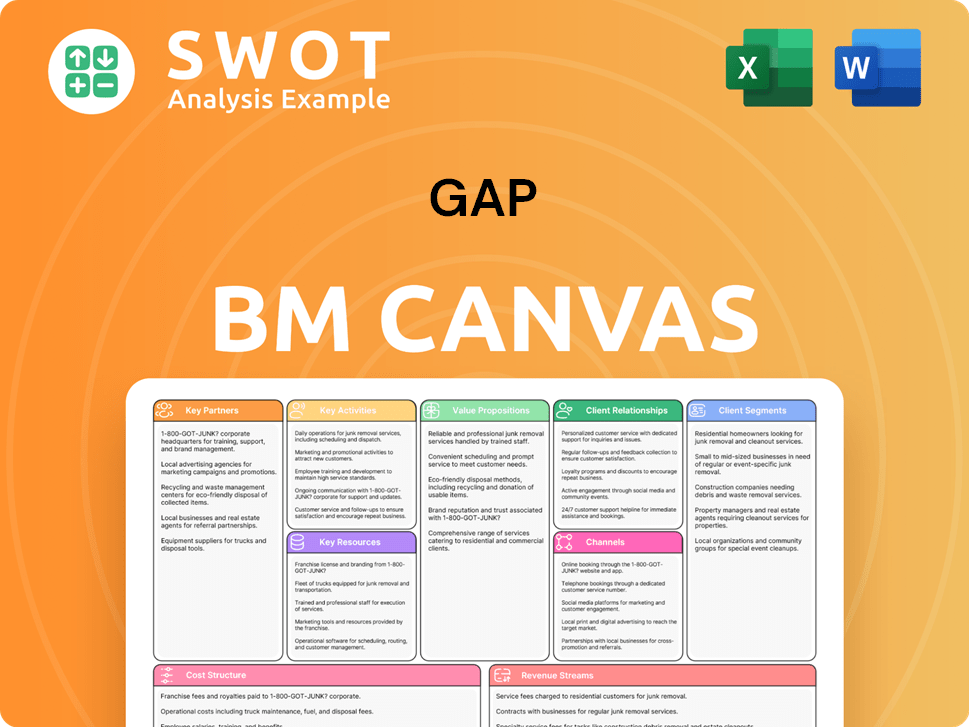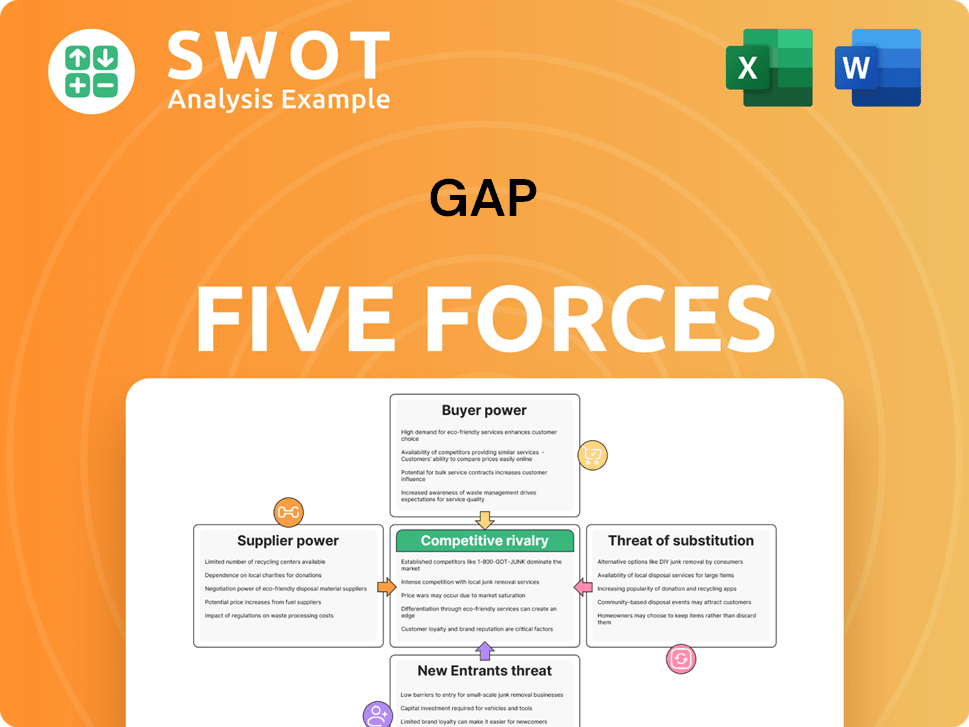Gap Bundle
How has Gap Inc. stayed relevant for over 50 years?
Gap Inc., a global retail giant, has consistently adapted its Gap SWOT Analysis to thrive in a constantly evolving market. From its humble beginnings in 1969, Gap has built a powerful brand and a loyal customer base. But how has the company crafted its sales and marketing strategy to remain a leading force in the competitive apparel industry?

This analysis explores the Gap sales strategy and Gap marketing strategy, examining how Gap Inc. reaches its Gap target market through diverse channels. We'll uncover the key elements of its Gap company strategy, including its Gap brand positioning and Gap competitive analysis. Furthermore, we'll dissect Gap's digital marketing strategy, Gap's current marketing campaigns, and its approach to customer retention, providing insights into its omnichannel sales strategy and expansion strategies.
How Does Gap Reach Its Customers?
The sales channels of the company, a prominent player in the apparel industry, are multifaceted, encompassing both physical and digital platforms to engage its diverse customer base. The company's primary sales channels include a network of company-operated retail stores, e-commerce platforms, and, to a lesser extent, franchise stores. This strategic approach allows the company to cater to various consumer preferences, ensuring accessibility and convenience.
The company has strategically evolved its sales channels, with a significant shift towards digital adoption and omnichannel integration. This evolution reflects the changing consumer behavior and the increasing preference for online shopping. The company has invested heavily in its e-commerce capabilities, recognizing the importance of a strong online presence to drive sales and enhance customer experience. This strategic focus has been instrumental in adapting to the evolving retail landscape and meeting the demands of its target market.
As of the end of fiscal year 2023, the company operated 2,906 company-operated stores across its brands, with a significant portion located in North America. The company's e-commerce platforms have become increasingly vital, contributing substantially to its net sales. For instance, in fiscal year 2023, online sales represented 38% of the company's total net sales. This marks a significant increase from previous years, highlighting the strategic importance of its e-commerce platforms. The company has also focused on integrating its online and offline experiences, offering services like 'Buy Online, Pick Up In Store' (BOPIS) to provide a seamless customer journey.
The company maintains a substantial network of company-operated retail stores, providing a physical presence for customers to experience the brand firsthand. These stores are crucial for brand experience and immediate gratification. The physical stores offer a tangible connection with the brand, allowing customers to interact with products and receive personalized service.
The company's e-commerce platforms are a critical component of its sales strategy, catering to the growing preference for online shopping. The company has invested significantly in its digital infrastructure, offering a seamless online shopping experience. Online sales represented 38% of total net sales in fiscal year 2023, demonstrating the importance of this channel.
Franchise stores contribute to the company's sales channels, although to a lesser extent compared to company-operated stores and e-commerce. Franchise stores expand the company's reach and presence in various markets. This channel allows for broader market penetration and leverages local market expertise.
The company focuses on integrating its online and offline experiences to provide a seamless customer journey. Services like 'Buy Online, Pick Up In Store' (BOPIS) enhance customer convenience. This approach underscores the company's commitment to meeting customer needs across multiple touchpoints.
The Gap sales strategy emphasizes a balanced approach that prioritizes digital accessibility and convenience while maintaining a strong physical retail presence. The company's Gap marketing strategy includes significant investments in e-commerce, which has led to substantial growth in online sales. The company's strategic focus on omnichannel integration further enhances the customer experience.
- Online sales accounted for 38% of total net sales in fiscal year 2023.
- The company operated 2,906 company-operated stores as of the end of fiscal year 2023.
- The company continues to adapt its Gap company strategy to meet evolving consumer behaviors.
- The company's approach reflects a commitment to adapting to market trends and enhancing customer experience, as detailed in an analysis of Owners & Shareholders of Gap.
Gap SWOT Analysis
- Complete SWOT Breakdown
- Fully Customizable
- Editable in Excel & Word
- Professional Formatting
- Investor-Ready Format

What Marketing Tactics Does Gap Use?
The company, like other major retailers, employs a multifaceted marketing strategy to boost brand recognition and drive sales. This approach encompasses a blend of digital and traditional marketing techniques, with a strong emphasis on data-driven insights to personalize customer experiences.
The company's marketing efforts are designed to reach a broad audience while also catering to specific customer segments. This is achieved through a combination of content marketing, search engine optimization (SEO), paid advertising, and social media engagement. The company also leverages influencer collaborations and event marketing to further amplify its brand message.
By analyzing customer data, the company aims to optimize its marketing campaigns and improve customer retention. The company's marketing mix has evolved to prioritize digital strategies while maintaining a presence in traditional media. This approach allows the company to adapt to changing consumer preferences and market trends.
The company heavily invests in digital marketing, including content marketing through brand blogs and social media. SEO is crucial for e-commerce visibility, and paid advertising targets specific audiences. Email marketing delivers personalized promotions and updates.
Social media platforms like Instagram, Facebook, TikTok, and Pinterest are essential for visual storytelling and customer interaction. Old Navy, for instance, uses TikTok for viral challenges to engage younger demographics. This is a key part of the Growth Strategy of Gap.
Traditional media, such as TV commercials and print ads, remains part of the marketing mix, especially for broader campaigns. Event marketing, including fashion shows, also creates immersive brand experiences. These strategies support the overall Gap marketing strategy.
The company uses customer segmentation and personalization to deliver relevant content and offers. Customer data, including purchase history and browsing behavior, informs targeted marketing communications. This is a core element of their Gap sales strategy.
Significant investments are made in CRM systems and marketing automation platforms. These tools manage customer data and execute targeted campaigns efficiently. AI-driven personalization in email marketing and live shopping on social media are notable innovations.
The marketing mix has shifted towards digital-first strategies while maintaining a presence in traditional media. The company explores new platforms like live shopping on social media. This approach helps adapt to changing consumer preferences.
The company's marketing tactics are designed to build brand awareness and drive sales. They focus on digital channels while still using traditional media. Data-driven insights are used to personalize customer experiences and optimize campaigns. These tactics are vital for the Gap company strategy.
- Content Marketing: Brand blogs and social media showcasing new arrivals and styling tips.
- SEO: Ensuring high visibility for e-commerce sites.
- Paid Advertising: SEM and display advertising across platforms.
- Email Marketing: Personalized promotions and updates.
- Influencer Partnerships: Collaborations to amplify brand messages.
- Social Media: Platforms for visual storytelling and customer interaction.
- Traditional Media: Television, print, and out-of-home advertising.
- Event Marketing: Fashion shows and in-store events.
- Data-Driven Marketing: Customer segmentation and personalization.
Gap PESTLE Analysis
- Covers All 6 PESTLE Categories
- No Research Needed – Save Hours of Work
- Built by Experts, Trusted by Consultants
- Instant Download, Ready to Use
- 100% Editable, Fully Customizable

How Is Gap Positioned in the Market?
The Gap company distinguishes itself in the apparel market through distinct brand identities for its core brands: Gap, Old Navy, Banana Republic, and Athleta. This strategy allows the company to cater to different customer segments and preferences, enhancing its overall market presence. Understanding the Gap sales strategy and Gap marketing strategy involves recognizing how each brand is positioned to resonate with its specific target demographic.
The Gap brand, for instance, focuses on classic, casual American style, appealing to a broad demographic. Old Navy emphasizes value and affordability, while Banana Republic targets a more sophisticated audience. Athleta caters to the athleisure market, emphasizing performance and sustainability. This multifaceted approach is a key aspect of the Gap company strategy, enabling it to compete effectively in a dynamic market.
This brand positioning strategy is crucial for the Gap to maintain its relevance and appeal to its diverse customer base. By clearly defining the value proposition of each brand, the company can effectively communicate its message and drive sales. Analyzing the Gap brand positioning provides insights into its ability to adapt to changing consumer preferences and maintain a competitive edge.
Gap is positioned as offering classic, casual American style, appealing to a broad demographic seeking comfortable and timeless apparel. Its core message revolves around everyday essentials and democratic fashion. The visual identity is clean and minimalist, often featuring its iconic block logo, while the tone of voice is approachable and inclusive.
Old Navy is positioned as a value-oriented brand, focusing on affordable fashion for the entire family. Its messaging emphasizes fun, family, and accessibility, with a vibrant visual identity and an energetic tone of voice. This brand appeals to a wide audience seeking budget-friendly options without sacrificing style.
Banana Republic targets a more sophisticated, modern professional audience, offering elevated, versatile apparel and accessories. Its brand identity conveys refinement and quality, with a polished visual aesthetic and a more aspirational tone. This brand focuses on providing premium products for a discerning customer base.
Athleta is positioned in the athleisure market, focusing on performance apparel for women and girls. Its core message centers on empowering women through movement and wellness, emphasizing sustainability and community. The visual identity is dynamic and active, with an inspiring and empowering tone, reflecting a commitment to both performance and social responsibility.
The company's ability to adapt its brand messaging and product offerings is crucial. For example, in response to growing consumer demand for sustainable practices, the company has increased its use of recycled materials and promoted ethical sourcing across its brands. The Gap target market is diverse, and the company's ability to cater to these different segments is a key driver of its success. To understand how the company generates revenue, you can explore the Revenue Streams & Business Model of Gap.
Gap Business Model Canvas
- Complete 9-Block Business Model Canvas
- Effortlessly Communicate Your Business Strategy
- Investor-Ready BMC Format
- 100% Editable and Customizable
- Clear and Structured Layout

What Are Gap’s Most Notable Campaigns?
The sales and marketing strategies of the company are multifaceted, encompassing various campaigns across its brands. These campaigns are designed to drive sales, enhance brand visibility, and connect with diverse consumer segments. The company's approach includes both traditional and digital marketing techniques, leveraging social media, influencer collaborations, and in-store displays.
Key campaigns often focus on seasonal promotions, family-oriented themes, and collaborations to boost engagement and sales. The company's marketing mix elements are carefully crafted to resonate with its target market, ensuring effective customer acquisition and retention. The company's digital marketing strategy is a crucial component, especially through social media.
The company's brand-specific marketing campaigns highlight the importance of understanding the target market and adapting strategies accordingly. For instance, campaigns like the 'Individuals of Modern' campaign aim to boost brand relevance among younger demographics. The company's sales performance review reflects the impact of these strategies on overall revenue and market share.
The 'Individuals of Modern' campaign, launched in 2024, focused on celebrating individuality. This campaign used digital channels, including social media and the brand's website, to reach a younger demographic. The goal was to increase brand relevance and engagement by highlighting the classic denim and khakis.
Old Navy focuses on seasonal family-oriented promotions, such as the 'Matching Family Pajamas' campaign. These campaigns leverage social media and television commercials. This strategy is successful due to its broad appeal and ability to tap into consumer traditions.
Athleta's 'Power of She' campaign highlights female athletes and their achievements. This campaign uses digital content, influencer collaborations, and social media. Athleta also emphasizes sustainability in its marketing, resonating with environmentally conscious consumers.
The company has partnered with designers and artists, such as the recent collaboration with Dapper Dan. These collaborations often involve limited-edition product drops and social media to create excitement. These efforts boost brand visibility and cultural relevance.
The success of the company's marketing campaigns lies in authentic storytelling, diverse representation, and leveraging digital platforms. These strategies are designed to engage the target market and drive sales. The company's approach includes a mix of digital and traditional marketing techniques.
- Digital Focus: The primary focus is on digital channels, including social media and the brand's website.
- Seasonal Promotions: Campaigns are often tied to seasonal events, like holidays, to boost sales.
- Collaborations: Partnerships with designers and artists create buzz and drive limited-edition sales.
- Sustainability: Athleta's emphasis on sustainability resonates with consumers.
- Influencer Marketing: Influencer collaborations with athletes and other personalities are used.
Gap Porter's Five Forces Analysis
- Covers All 5 Competitive Forces in Detail
- Structured for Consultants, Students, and Founders
- 100% Editable in Microsoft Word & Excel
- Instant Digital Download – Use Immediately
- Compatible with Mac & PC – Fully Unlocked

Related Blogs
- What are Mission Vision & Core Values of Gap Company?
- What is Competitive Landscape of Gap Company?
- What is Growth Strategy and Future Prospects of Gap Company?
- How Does Gap Company Work?
- What is Brief History of Gap Company?
- Who Owns Gap Company?
- What is Customer Demographics and Target Market of Gap Company?
Disclaimer
All information, articles, and product details provided on this website are for general informational and educational purposes only. We do not claim any ownership over, nor do we intend to infringe upon, any trademarks, copyrights, logos, brand names, or other intellectual property mentioned or depicted on this site. Such intellectual property remains the property of its respective owners, and any references here are made solely for identification or informational purposes, without implying any affiliation, endorsement, or partnership.
We make no representations or warranties, express or implied, regarding the accuracy, completeness, or suitability of any content or products presented. Nothing on this website should be construed as legal, tax, investment, financial, medical, or other professional advice. In addition, no part of this site—including articles or product references—constitutes a solicitation, recommendation, endorsement, advertisement, or offer to buy or sell any securities, franchises, or other financial instruments, particularly in jurisdictions where such activity would be unlawful.
All content is of a general nature and may not address the specific circumstances of any individual or entity. It is not a substitute for professional advice or services. Any actions you take based on the information provided here are strictly at your own risk. You accept full responsibility for any decisions or outcomes arising from your use of this website and agree to release us from any liability in connection with your use of, or reliance upon, the content or products found herein.